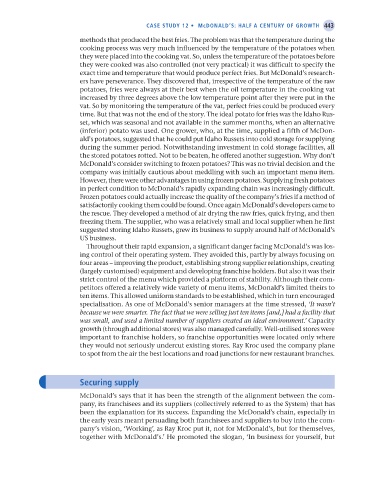Page 468 - Operations Strategy
P. 468
case study 12 • McDONALD’S: hALf A ceNtury Of grOwth 443
methods that produced the best fries. The problem was that the temperature during the
cooking process was very much influenced by the temperature of the potatoes when
they were placed into the cooking vat. So, unless the temperature of the potatoes before
they were cooked was also controlled (not very practical) it was difficult to specify the
exact time and temperature that would produce perfect fries. But McDonald’s research-
ers have perseverance. They discovered that, irrespective of the temperature of the raw
potatoes, fries were always at their best when the oil temperature in the cooking vat
increased by three degrees above the low temperature point after they were put in the
vat. So by monitoring the temperature of the vat, perfect fries could be produced every
time. But that was not the end of the story. The ideal potato for fries was the Idaho Rus-
set, which was seasonal and not available in the summer months, when an alternative
(inferior) potato was used. One grower, who, at the time, supplied a fifth of McDon-
ald’s potatoes, suggested that he could put Idaho Russets into cold storage for supplying
during the summer period. Notwithstanding investment in cold storage facilities, all
the stored potatoes rotted. Not to be beaten, he offered another suggestion. Why don’t
McDonald’s consider switching to frozen potatoes? This was no trivial decision and the
company was initially cautious about meddling with such an important menu item.
However, there were other advantages in using frozen potatoes. Supplying fresh potatoes
in perfect condition to McDonald’s rapidly expanding chain was increasingly difficult.
Frozen potatoes could actually increase the quality of the company’s fries if a method of
satisfactorily cooking them could be found. Once again McDonald’s developers came to
the rescue. They developed a method of air drying the raw fries, quick frying, and then
freezing them. The supplier, who was a relatively small and local supplier when he first
suggested storing Idaho Russets, grew its business to supply around half of McDonald’s
US business.
Throughout their rapid expansion, a significant danger facing McDonald’s was los-
ing control of their operating system. They avoided this, partly by always focusing on
four areas – improving the product, establishing strong supplier relationships, creating
(largely customised) equipment and developing franchise holders. But also it was their
strict control of the menu which provided a platform of stability. Although their com-
petitors offered a relatively wide variety of menu items, McDonald’s limited theirs to
ten items. This allowed uniform standards to be established, which in turn encouraged
specialisation. As one of McDonald’s senior managers at the time stressed, ‘It wasn’t
because we were smarter. The fact that we were selling just ten items [and,] had a facility that
was small, and used a limited number of suppliers created an ideal environment.’ Capacity
growth (through additional stores) was also managed carefully. Well-utilised stores were
important to franchise holders, so franchise opportunities were located only where
they would not seriously undercut existing stores. Ray Kroc used the company plane
to spot from the air the best locations and road junctions for new restaurant branches.
Securing supply
McDonald’s says that it has been the strength of the alignment between the com-
pany, its franchisees and its suppliers (collectively referred to as the System) that has
been the explanation for its success. Expanding the McDonald’s chain, especially in
the early years meant persuading both franchisees and suppliers to buy into the com-
pany’s vision, ‘Working’, as Ray Kroc put it, not for McDonald’s, but for themselves,
together with McDonald’s.’ He promoted the slogan, ‘In business for yourself, but
Z12 Operations Strategy 62492.indd 443 02/03/2017 13:56

